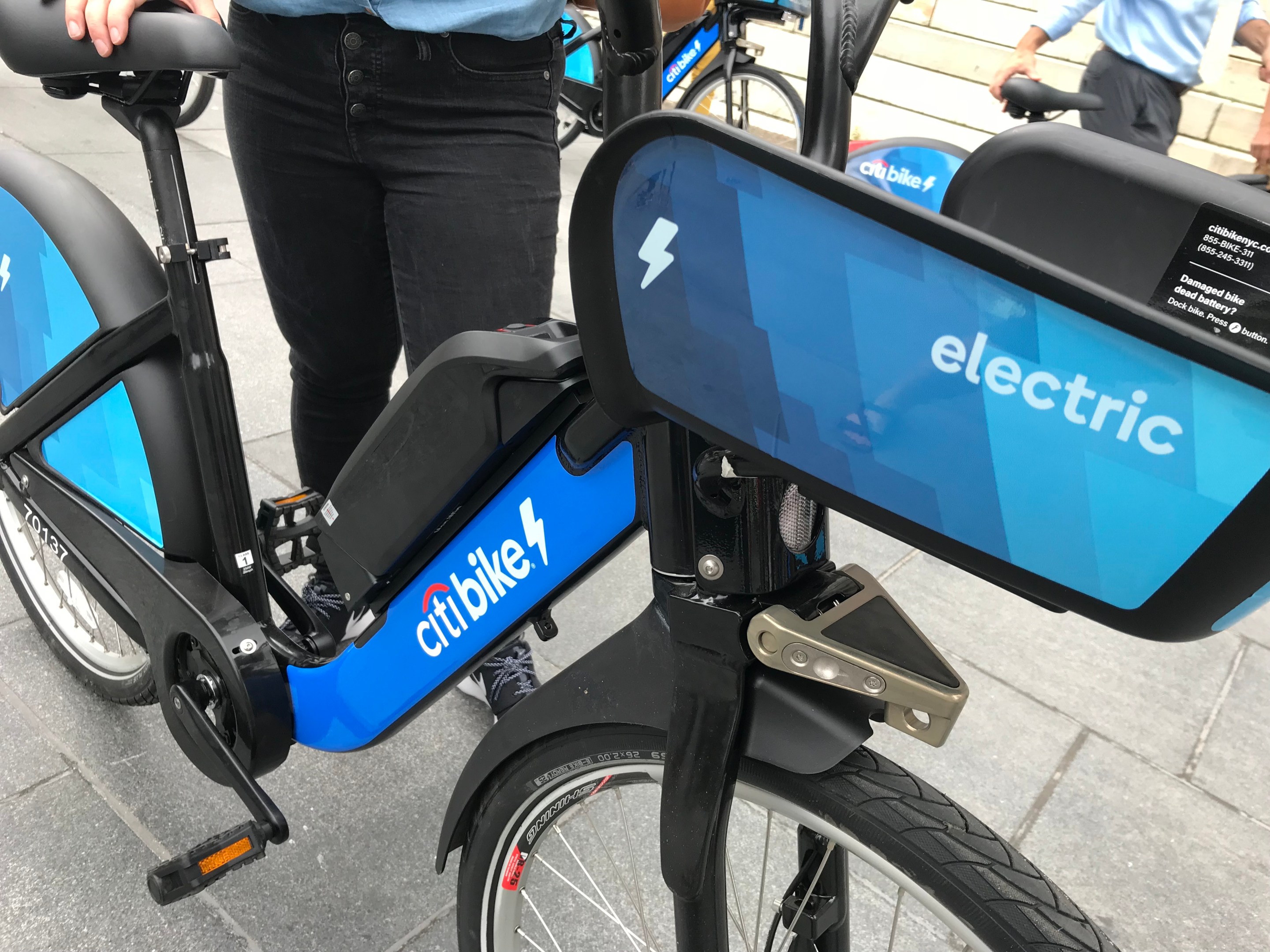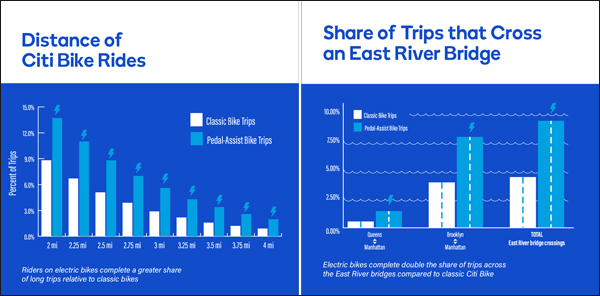Citi Bike's electric fleet will grow from just 200 to 4,000 pedal-assist bikes by the end of spring as part of a major expansion of — and a price increase on — the bike-share system's most-popular vehicles, the company said on Thursday.
Riders will pay $2 per ride for the electronic boost, meaning that a single-trip e-ride will rise to $5, starting today. Annual members, who pay $169, will also be charged the $2 e-bike fee, starting on April 27. NYCHA residents and SNAP recipients, who pay $60 per year, will pay 50 cents per e-ride, also starting on that date.
The fees do not apply if, for some reason, the only bike in a dock is an electric one.
The additional cost is necessary because swapping out batteries is labor-intensive, said Julie Wood, a spokeswoman for Citi Bike, which will hire "dozens" of new union workers to handle the challenge. Wood added that the company will ask its 150,000-plus members if the company should create a new annual plan that would include unlimited e-bike use, albeit for a higher fee.
The company believes members and non-members will accept the fee because of the overwhelming appeal of Citi Bike's pedal-assist machines, which allow for far longer, virtually effortless commutes. (The $2 will also be waived for riders who park at certain stations near the L train during that line's reduced service hours.)
"We think of e-bikes as a different mode of transportation," Wood said. "Many people currently use Citi Bike for a short trip or to solve a long walk, but the pedal-assist bikes will open up a completely new way of thinking about Citi Bike. I personally don't use Citi Bike to go from Park Slope to Manhattan. But I would definitely take an electric bike. It's a 20-minute trip. So you see how pedal-assist bikes open up a whole range of possibilities for New York's transit system."
The company released statistics to back up that claim. Each electric Citi Bike, for example, gets ridden roughly 15 times per day, compared to five times per day for the standard bike (which Citi Bike is now officially calling "classic"). E-bike ridership does not decline during the winter. And the distances traveled by e-Citi Bikes are far greater, with roughly 18 percent of e-bike trips greater than three miles, versus just 10.7 percent of classic Citi Bike trips going that long.
Currently, about 10 percent of Citi Bike trips across an East River bridge are done on the pedal-assist bikes, compared to about 5 percent.
That number will likely grow considerably once Citi Bike expands its fleet beyond much of Manhattan and a narrow swath of western Queens and Brownstone Brooklyn. Residents of Jackson Heights, Corona, the Bronx, Sunset Park and Bushwick would certainly use electric Citi Bikes if they were available. The company announced in November that it will expand its overall fleet to 40,000 bikes over the next five years, but it has not revealed the lucky neighborhoods that will comprise the first phase of that expansion.
The existing 200 battery-powered pedal-assist bikes have proven to be popular — when riders can find them.
“There are two types of people in the world,” former Citi Bike CEO Jay Walder famously said when the e-bikes were introduced in August. “People who have never tried a pedal-assist bike and people who won’t shut up about them.”
Urban planner and annual Citi Bike key-holder Mike Lydon has used one of the electric bikes just once and was impressed. He thinks the $2 fee will create different types of Citi Bike users.
"If you're using it for a short, relatively flat trip, you may be more likely to use the regular Citi Bike, but if you're going a longer distance or over a bridge, you'll prefer the electric bike," said Lydon, a principal at the urban planning firm Street Plans. "And the fee could discourage some people from taking the electric bike if they don't need it, meaning there will be more e-bikes for the people who need to make the longer or more physically taxing trip."
That Dickensian "Tale of Two E-Bikes" is actually in keeping with the philosophy at Citi Bike, currently owned by Lyft, which explained the company's larger goal of replacing more car trips with e-bikes in a Medium post today.
"Because pedal-assist bikes can be used more easily for longer, steeper trips, they are more likely to replace car trips, combating congestion, reducing pollution, and making the city more livable," the company said in a statement.
Still, the announcement does raise some unanswered questions:
- Many riders complain that Citi Bike has not completely perfected fleet balancing, and the addition of 4,000 new bikes could complicate matters. Will Citi Bike hire enough workers?
- Some annual members will likely balk at paying $2 more for an electric bike, especially members who pay $169 per year, but only ride occasionally. Will e-bike ridership actually decline as a result of the fee?
- It is unclear how much a "Citi Bike-Plus" membership will cost. Will members resist new fees — even for unlimited use of electric bikes — if the cost is seen as too high?
- When will the solar-powered Citi Bike docks themselves be able to re-charge spent batteries?
"The current technology does not generate enough power, so for now, we have to hire a lot of folks to go and charge batteries," Wood said. "And that's part of the $2 fee. Other companies in this industry have flamed out because of prices that are too low and costs that are too high. But Citi Bike is part of the city's transportation network, so it has to be sustainable."
New York City got congestion pricing for e-bikes before it got congestion pricing for single-occupancy cars 🤷🏻♂️ pic.twitter.com/KZHnPsq4Mx
— Travis R. Eby (@travis_robert) February 28, 2019
.@CitiBikeNYC No good! Why do members have to pay extra for the eBike? Not happy. #bikenyc @motivate_co https://t.co/gxSH0HfPAH
— Kenneth Miraski (@kmiraski) February 28, 2019
She also said that having more e-bikes might make the company more efficient at replacing batteries and keep e-bikes on the road.
"Right now, we have 200 bikes out of a fleet of 12,000 at 750 docking stations that are scattered all over," she said. "When we get to greater scale, where there are electric bikes at every station, it will be much easier to swap them out in an efficient way."
Update: After initial publication of this story, Jump Bikes, a would-be Citi Bike competitor that is operating a dockless system with pedal-assist e-bikes in several neighborhoods of the Bronx and Staten Island, issued a statement: “Millions of New Yorkers don’t have access to Citi Bikes, and we’re asking the Department of Transportation to allow JUMP bikes to serve those New Yorkers forgotten by Citi Bike.”









